Landscaping Around an Above-Ground Pool
- Milorganite AgronomistJune 14, 2025
Landscaping Around Your Above-Ground Pool for Aesthetics and Safety
There are 6.1 million residential in-ground pools and 4.3 million residential above-ground pools in the country. That represents 8% of households. That means a lot of pool-side landscaping.
Landscaping around your above-ground pool helps to seamlessly incorporate it into your current landscaping. You can create a private retreat in a style that fits your home and achieves the feel you’re looking for. It can be tropical, formal, organic, informal, or anything in between.
Landscaping doesn’t have to break the bank. The materials you’ll need for a poolside landscaping transformation are readily available.
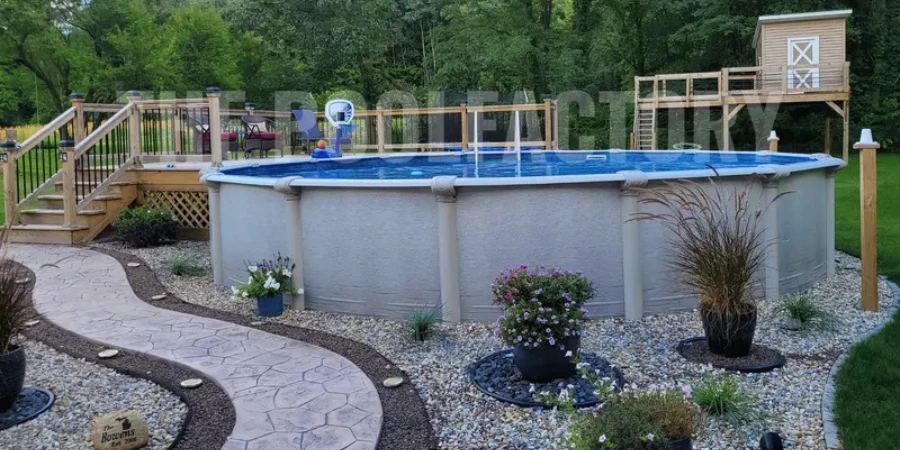
Photo Credit: The Pool Factory
Basic Plant Requirements
There are some basics to consider when selecting plants for pool-side landscaping, as well as any other plant for your yard and garden.
Is the plant hardy in your area? Go to the USDA Plant Hardiness Zone Map and enter your zip code to find out in what hardiness zone you live.
Are the plants drought-tolerant? This is important to consider in areas that frequently experience extended periods of dry weather.
What are the light requirements? Pools are typically positioned to receive as much daylight as possible. Choose plants that tolerate full sun to part shade. Here’s something you may not have considered for poolside plantings. Is the shrub or plant chlorine or salt-tolerant?
Choose Chlorine- and Salt-Tolerant Plants
It’s important to select plants that can tolerate some splashing with chlorine or salt, in the case of a saltwater pool or if you live in a coastal location. Plants adapted to coastal conditions and salt mist are generally tolerant of chlorine.
Mediterranean plants are a good example, as they are generally well-adapted to salty environments and are known to do well. Plants with waxy, leathery, or succulent foliage can help provide natural protection against chlorine and salt.
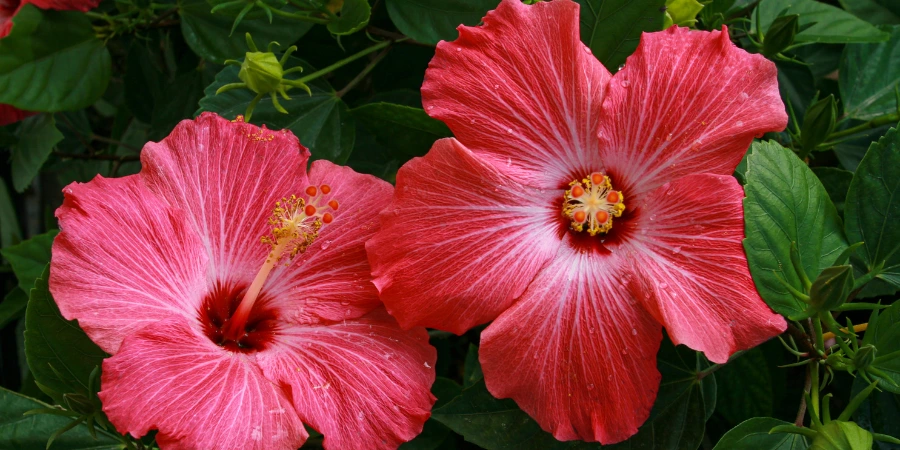
Chinese Hibiscus
Just a few plants that are considered chlorine tolerant include palm trees, Chinese hibiscus, honeysuckle, rosemary, and lavender.
Do a little research to ensure the plants you choose are suitable for landscaping next to your pool. Check out the Backyard Boss article, Chemicals in Pool Water: Which Plants Can Take It? There you’ll find recommendations for chlorine-tolerant plants. Although many plants may tolerate a splash of chlorine or salt, avoid direct splashes and concentrated chlorine from backwash. No matter what plants you choose, it’s a good idea to occasionally flush the salts that may have accumulated in the soil with a deep watering.
Pools Don’t Like Messy Plants
It’s not possible for me to make specific plant recommendations for every growing condition throughout the country. Instead, I can offer general guidelines.
Avoid plants that drop their leaves, fruit, and petals, which can stain paving and pool liners, as well as clog filtration systems. Evergreens and decorative grasses are just two examples of “clean” plants to consider for your pool landscaping.
For information on plant considerations for pool-side landscaping in your area, contact your local Institute of Food and Agriculture Sciences (IFAS) Extension office in your county for guidance.
Plant Height, Growth Rate, Ease of Maintenance
Landscaping around an above-ground pool helps incorporate it into your yard. Mature plant heights in the 2’-3’ range is a good rule-of-thumb for above-ground pools. You may want to camouflage the pool and incorporate it into the yard, but plants that grow too tall can be a safety hazard if they obscure your sightline to the pool. Using plants of varying heights will create visual interest in a casual setting.
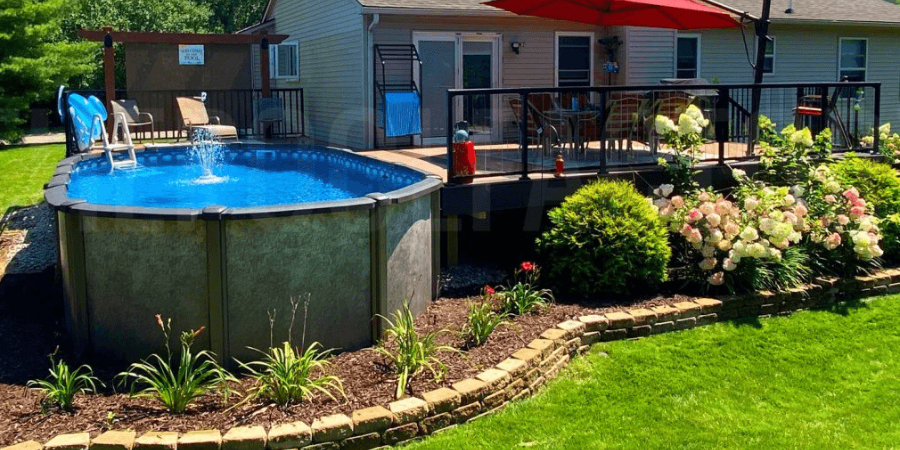
Photo Credit: DFW Turf
Choose slow-growing plants. You may want instant landscaping, but if the shrubs and plants grow too quickly, you’ll be doing more maintenance in the future to keep them in check.
Choose Plants with Compact Root Systems
Here’s something you may have never considered: roots. Avoid plants with aggressive, extensive root systems. Root systems can extend under pools, possibly damaging pool liners and concrete, which could be particularly problematic for in-ground pools. Aggressive root systems may also damage walks, hardscapes, and underground plumbing.
When selecting trees and shrubs, you will need to know their root growth patterns. Trees and shrubs with small, compact root systems, spherical roots, or vertical root systems are desirable.
Before you choose or plant anything, it’s advisable to review the manufacturer’s or builder’s warranty. Plants with aggressive root systems may be prohibited due to potential damage and could void your warranty.
Balance Privacy with Safety
You want to keep your backyard getaway private from neighbors and passersby, and a privacy screen may work. It doesn’t need to be near the pool; it just needs to provide the privacy you’re looking for. It can be a living privacy screen or a freestanding wall. The possibilities are endless.
A lattice panel with quick-growing vines can provide a cost-effective solution. It can be temporary until evergreens and shrubs are tall enough to provide privacy or a permanent addition to your landscape.
Slow-growing plants aren’t a requirement here. Choose fast-growing shrubs that can quickly block the view of your pool from others. A natural screen doesn’t have to be a single plant variety. Choose various evergreens and shrubs that will thrive in similar growing conditions.
Don’t sacrifice privacy for safety. No matter what type of privacy screen you decide on, it should not prevent you from monitoring the pool from the house or other parts of the yard. This is especially critical when children are enjoying the pool.
Coordinate Landscape Design with House, Yard
One of your landscaping goals is likely to incorporate your pool into the yard. Poolside landscaping should enhance the current style of your home and yard.
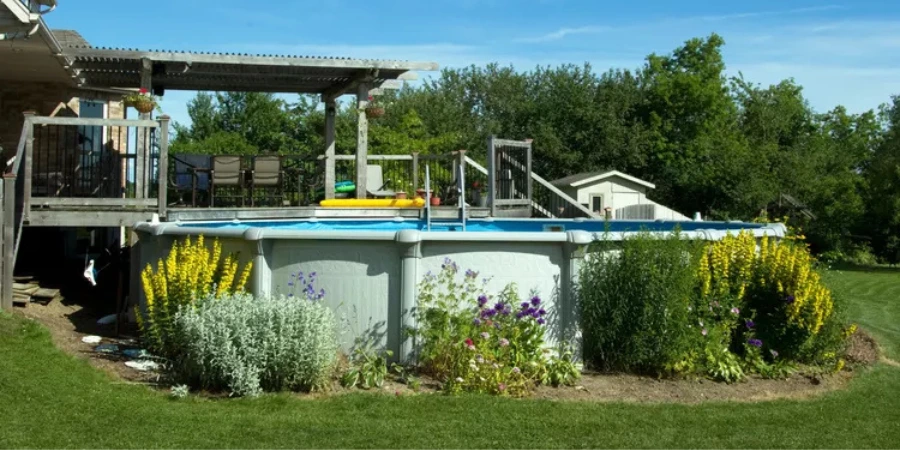
Photo Credit: SimplyCreativePhotography/Getty Images
For a contemporary look, landscaping should be organized and deliberate.
Look for plants with straight lines with tidy growth habits. Ornamental grasses and trimmed boxwood hedges are examples. Use the same plant in repetition for a clean look.
Some landscapes have a more natural aesthetic. Select plants with a free-form growth habit in various shapes and textures. An English-country style garden is a good example, but you can use the same concept in hot or tropical areas of the country as well.
A Tropical Escape in Colder Climates
Achieving a tropical escape isn’t very difficult in areas where palms and tropical plants flourish. But what if you want to import that tropical feeling north?
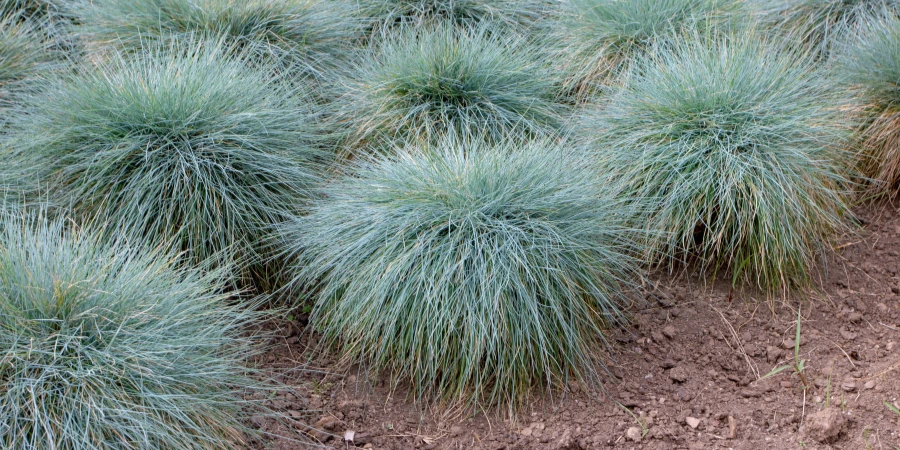
Blue Fescue Ornamental Grass
Ornamental grasses that easily catch the breeze can help create a tropical look. Select different varieties that vary in height and color for a greater visual impact. Taller grasses can be planted so they arch over the water and sway in the breeze. Ornamental grasses tend to have a tidy growth habit.
I’m going to make one specific plant recommendation to achieve a tropical look in the North: hardy hibiscus. If you’ve never seen one, you’ll be amazed! Some are suitable in hardiness zones 4–9. They can grow up to 4’ in height and width, depending on the variety, and will die back after the first frost. They bloom in mid-summer to late-fall, depending on your region. They have show-stopping flowers of up to 12” in diameter.
You can use planters and decorative pots to grow tropical plants outside their range and bring them in during the winter. You may want to consider them as focal points in the landscaping. Even one potted palm can be an inspiration for the remainder of the landscaping.
Landscape to Repel Flying Pests
Mosquitoes, wasps, and other flying pests can be a nuisance when you’re trying to enjoy your pool. Plants with strong scents can help repel flying pests, such as peppermint, lavender, rosemary, lemon thyme, lemongrass, and a variety of basil species.
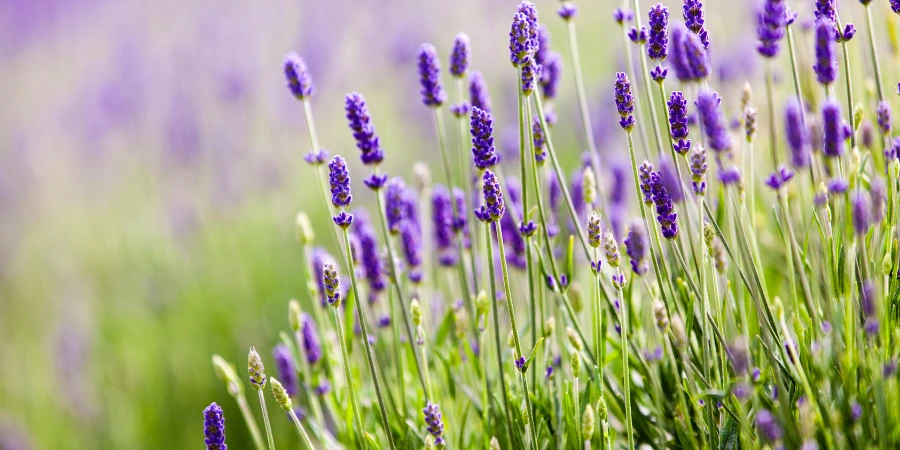
Lavender
Another method of dealing with pesky insects is to give them a place of their own to enjoy. Plant an insect-loving flower bed away from the pool to help keep them away from you.
Hardscaping
Hardscaping using pavers, gravel, stone, river rocks, fieldstone, and other durable materials, including wood and composites, can set the stage for landscaping. All of these materials are readily available in various colors, sizes, and shapes. Remember: darker colors absorb heat while lighter colors reflect heat.
Consider what the material is going to be used for. Gravel or river rock is an inexpensive material to create a path to the pool’s entrance, when compared to concrete, which can cost significantly more. Crushed granite wouldn’t be the best choice for walking paths, because of the potentially jagged or sharp edges. Stone walkways help keep grass and soil from getting into the pool.
If you already have yard furniture, where can you incorporate it into your new landscape? Lounge chairs next to the pool can create more of a retreat vibe.
Achieve a contemporary look using larger paver blocks placed symmetrically. Fieldstone can be used to create a patchwork path or seating area that’s less formal.
Distance from Pool to Start Landscaping
There are various opinions on how far from the pool wall landscaping should begin and what materials to use. To protect plants, some recommend leaving at least a yard of space between the pool and any landscaping, including lawn.
Do Not Use Stone, Gravel, or Mulch Around the Immediate Perimeter of Above-ground Pools
A stone border around the pool will help with drainage, deter weeds, and eliminate the need to use a weed wacker around the pool, possibly causing damage.
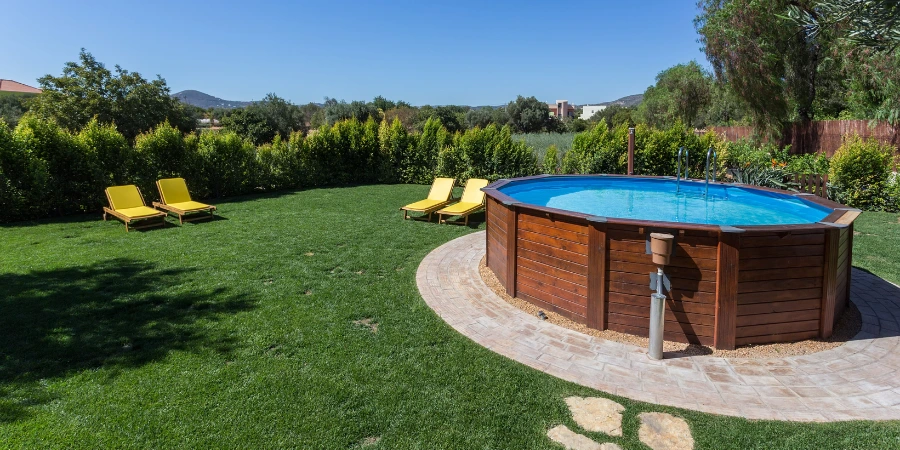
But there are differences of opinion as to whether it’s safe to use a stone or mulch border around the immediate perimeter of the pool. Some say it’s safe and they’ve done it for years. But, according to pool manufacturers and pool installers, you should always avoid placing stones, rocks, gravel, and mulch in direct contact with the pool walls of above-ground pools.
Most decorative rock is acidic and can acidify the soil, possibly damaging the pool. The sharp edges of rocks can scratch, puncture or chip the pool wall, leading to rust. Pools also vibrate when in use, which may cause the pool wall to rub against the stone.
To safely use stone as a border, it’s important to place a protective barrier between the pool wall and the stone you’re putting down. Materials recommended as a protective barrier include roofing rubber and tar paper. Some suggest heavy-duty landscaping cloth also provides an effective barrier. Even with the barrier in place, play it safe and use smooth stones, such as river rock or pea gravel, to further protect your pool from damage.
Mulch can also be problematic if it’s placed directly next to the pool. Mulch retains moisture and can create acidic soils, both of which can damage the pool.
In the end, the recommendation is to create a stone border using a barrier to protect the pool wall. Recommendations for the width of the border range from a foot to one yard. The wider stone perimeter provides clear access for ongoing pool maintenance and repair. You have access to the entire pool.
Here are the suggested steps for landscaping the perimeter of your pool to keep it from damage.
- Determine the desired width of the bed and prepare the soil for the new plantings. It’s easier to do it now, before you place the stone. (Details on how to prepare the soil and install plants is in the following section.)
- Install barrier material around the perimeter of the pool using either tar paper or roofing rubber. Place heavy-duty landscaping fabric on the exposed soil to help deter weeds from growing before adding the stone.
- If you’re using heavy-duty landscape fabric as the barrier, make sure it extends up the side of the pool wall enough to protect it from the stones.
- Use garden edging at the desired distance from the pool to keep the stone in place. Fill in with stone. You could stop here and allow grass to grow to the edging or create a bed for plants.
- Determine the desired width of the planting bed. Edge it using garden edging or natural materials. Ensure this slopes away from the pool.
- Plant the landscape trees, shrubs, and plants and mulch to a depth of 2”.
Planting and Maintaining Your Poolside Landscape
Make sure trees and shrubs are planted correctly and keep up with maintenance in the future.
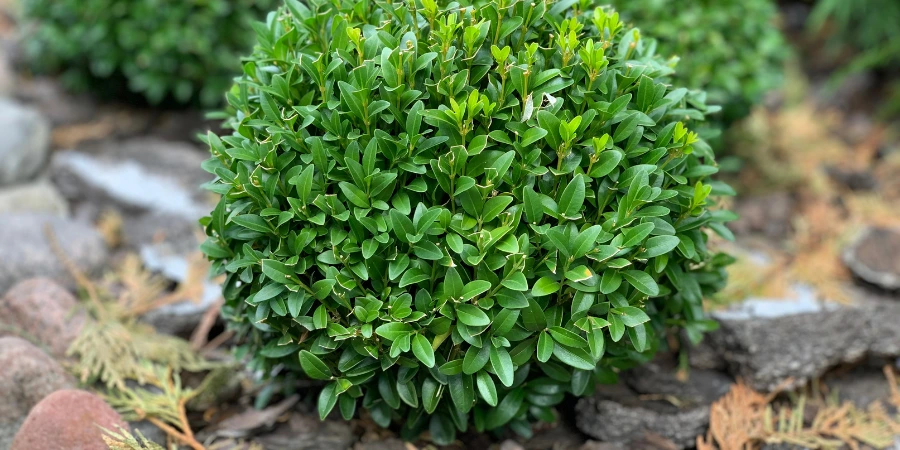
Boxwood shrubs have shallow root systems and are low-maintenance
It might surprise you, but it’s not a good idea to amend the soil when planting trees and shrubs. It’s counterintuitive, but not amending the soil promotes sustainable growth. Instead of adding amendments, dig the hole larger than you think you should and roughen up the soil. This encourages roots to grow beyond the hole into the surrounding soil. Amending the soil encourages roots to stay in the nice, loose soil you just created instead of sending out roots into native soil. If the roots don’t venture out, the plant may lose vigor or die.
Here are two posts that will help guide you in how to plant trees and shrubs correctly.
- Learn the Right Way to Plant Trees and Shrubs - Seven Steps to Ensure Success
- Do’s & Don’ts for Trees and Shrub Planting and Maintenance
Fertilize with Milorganite
Milorganite is an excellent fertilizer to use in your new poolside landscape. Milorganite is a low-nitrogen, slow-release, non-burning fertilizer. The low nitrogen and slow release of nutrients ensure shrubs and trees aren’t stressed from being forced to produce new growth.
It’s non-burning, so you won’t damage newly planted trees and shrubs, unlike synthetic fertilizers which can burn tender new roots.
Maybe the most important characteristic of Milorganite is that it’s safe for the entire family, from kids to pets.

